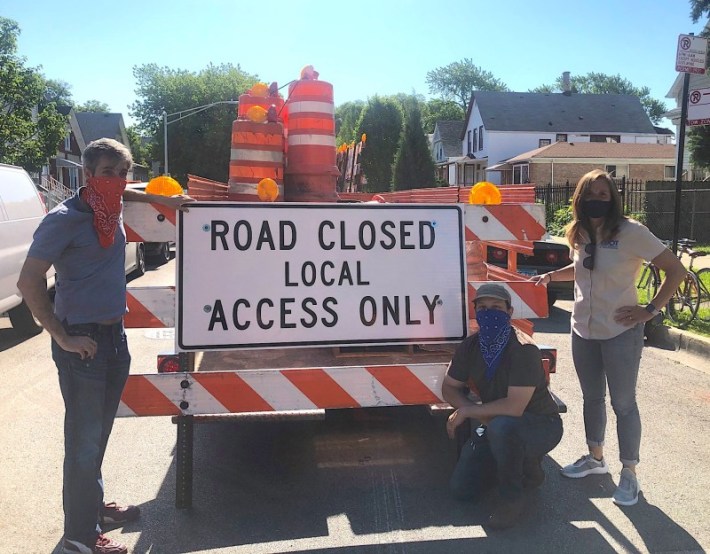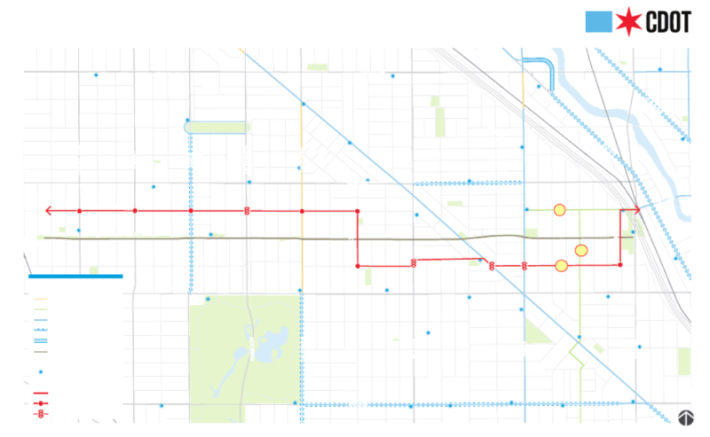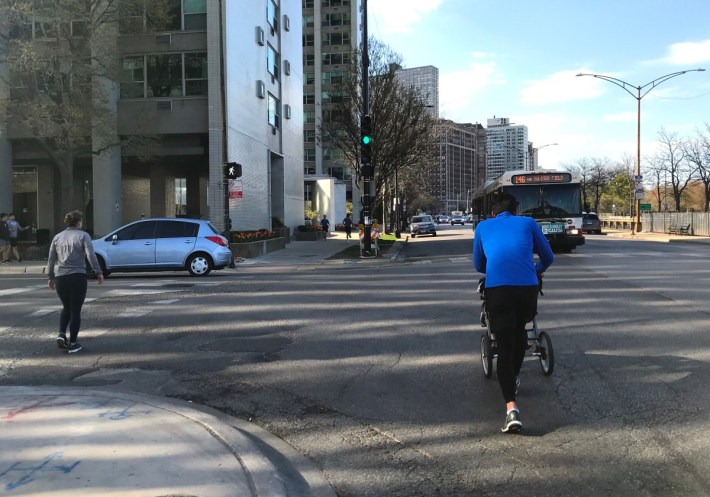Early on in the pandemic, cities across the country and around the world were taking action to create more space for socially-distanced pedestrian activity and biking, such as creating car-free or car-restricted streets, and converting parking and travel lanes to emergency sidewalk extensions, and bus or bike lanes. These kinds of interventions are broadly known as "open streets." For example, Oakland's influential Slow Streets program, which prohibits through traffic on side streets to enable safe walking, running, and cycling in the roadway, launched on April 11.
However, our city did nothing on the open streets front until May 29, when the Chicago Department of Transportation rolled out the first of several Slow Streets (the city is calling them "Shared Streets") on Leland Avenue in Ravenswood. The program has since proved very popular with residents. However, aside from Chicago's business-minded Cafe Streets program, which temporarily pedestrianizes restaurant strips to make for socially-distanced outdoor dining, our city has essentially done no other open streets interventions.
On April 14, a few weeks after Illinois' Stay at Home order kicked in, Streetsblog submitted a Freedom of Information Act request to CDOT asking for all emails to or from Commissioner Gia Biagi between March 14 and April 14 containing the phrase “open streets” in an effort to find out what was going on behind the scenes. By law FOIA requests are supposed to be answered within five business days, but CDOT requested countless extensions, claiming that it was impossible to access computer files from the department's downtown offices during lockdown.
Exactly three months after we submitted the request, yesterday CDOT finally provided a stack of heavily redacted emails. The correspondence shows that the department did consider bolder pandemic mobility strategies such as emergency bike lanes on main streets.
But ultimately CDOT took no action on these ideas during the window of time when motor vehicle traffic was down about 50 percent. Therefore Chicago largely missed the chance to make our main streets less car-centric when when doing so would have been relatively feasible from a political standpoint. That's no longer the case now that traffic volumes are close to normal again. Let's look at some of the correspondence.

On March 28, Commissioner Biagi sent CDOT managing deputy commissioner Kevin O'Malley and bicycle and pedestrian program manager Dave Smith an email titled "BikePed [Modus Operandi]." The version of the message forwarded to Streetsblog was almost completely blacked out save for this: "[Metropolitan Planning Council] and [redacted] are def interested in a convo. I’m trying to get that on Monday too. KO, I’ll send an invitation when it gets booked."
MPC and other transportation advocates lobbied for open streets interventions to accommodate increased walking and biking, and prevent a spike in driving. "Metropolitan Planning Council is advocating for planning now to prepare us for the transportation transition out of the stay-at-home order,” Wennink told Streetsblog in mid-April. “We’d hope to see the city implement ‘tactical urbanism’ type of improvements to upgrade the existing bike and pedestrian networks, like pop-up bike lanes and pedestrian paths in parking lanes.”
Think we don't need #openstreets in Chicago? People are speeding like crazy. Just now: SUV zooms down Paulina outside @RecycleryThe, hits car, spins onto other side of the street, knocks over 2 bike racks, parking meter, outdoor tool stand. Hope no one was hurt. pic.twitter.com/X9Oyog8j8Y
— Sam Kling (@SamKling2) April 16, 2020
In response to Biagi's March 28 email prior to the meeting with Wennink and Kling, Smith ewrote the commissioner and O'Malley that he would "compile the ideas."
"Get the ideas together, easy-med-hard," Biagi replied "Have simple options [redacted] as well as more robust ones."
On March 29 Deputy Commissioner O'Malley wrote Biagi and Smith, cc-ing fellow CDOT deputy and chief engineer Dan Burke, attaching documents titled "Active Transportation and Public Spacing Policies," "Bike Ped Ideas 2020," and "Pop-Up Bike Lanes." O'Malley wrote, "Commissioner, see latest working paper and spreadsheet on this. Also, the map Dave had put together last Tuesday is... attached."
When I asked a CDOT spokesperson for copies of these materials, I was told. "The attachments you are requesting were deemed 'pre-decisional' and will not be released, as they are in draft form."
On March 30 Smith wrote Biagi, O'Malley, and Burke, attaching documents titled "Bloomingdale Alternative," "[Lakefront Trail] Alternative," and "Transportation and Public Spacing Policies."
When I asked the CDOT spokesperson for copies of those documents, they replied, "Those were drafts too."

The first two documents were proposals to create Slow Street routes parallel to the Bloomingdale Trail and the shoreline path, which Mayor Lori Lightfoot had abruptly shut down four days earlier in the wake of crowding issues, with little or no community input. These closures of Chicago's most important car-free commuting routes would last almost three months.
"See attached maps showing (1) LFT Alternate Route and (2) Bloomingdale Alternate Route," Smith wrote. "I spoke with [Friends of the Bloomingdale Trail president Ben Helphand] -- he thinks the alternative concept is great and will help promote/support. They can also create quick signage (non-regulatory) that can incorporate the map and brief messaging - to be posted at the access points. They could work with [the Chicago Park District] on printing."
But inexplicably the Bloomingdale Alternative Slow Street route wasn't installed until 2.5 months later on June 12. That was a mere 10 days before the trail itself was reopened to the public after months of being off-limits, and a clear case of "locking the barn door after the horses are already stolen." And the lakefront alternative route was never implemented at all.

It's certainly disheartening to think of all the open streets projects that CDOT considered months ago to create safer conditions for pedestrians and cyclists during the pandemic, but never implemented. And considering that local roads are now clogged with cars again, it's increasingly unlikely that pop-up bike lanes, bus lanes, and sidewalk extensions will be a thing in Chicago anytime soon.




